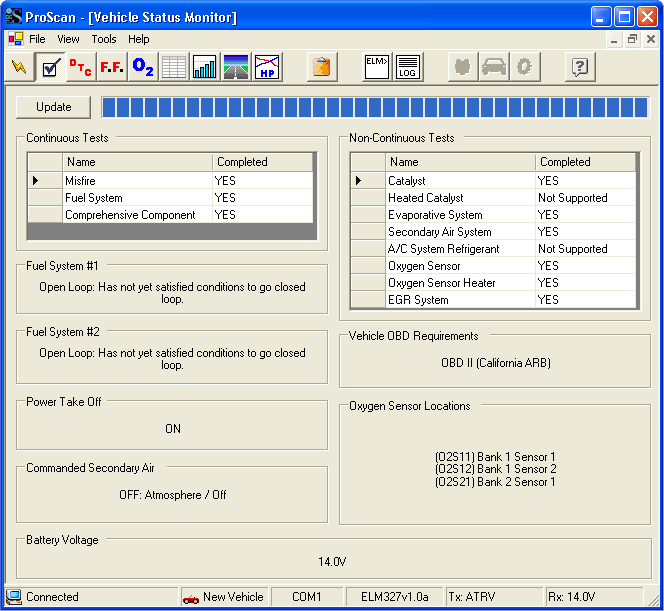
| Toolbar Icon: |
|

Image 1: Vehicle Status Monitor
Your vehicle’s diagnostic system routinely performs system readiness tests. If your vehicle is in good operating condition, all tests supported by your vehicle should complete successfully. The Vehicle Status Monitor allows you to view the results of these tests along with some other important information.
Updating the Display
When you switch to the Vehicle Status Monitor, you will need to update the display to reflect the vehicle’s current status. Simply click the “Update” button in the top left corner to gather the latest test results. The progress bar will keep you informed of the progress.
Continuous Tests
The Continuous Tests section displays whether or not your vehicle supports each continuous test, and if it does, whether or not the test has been successfully completed.
|
Misfire Monitoring Misfire monitoring shall be supported on both spark ignition and compression vehicles if the vehicle utilizes a misfire monitor. Misfire monitoring shall always indicate complete for spark ignition engines. Misfire monitoring shall indicate complete for compression ignition engines after the misfire evaluation is complete. |
|
Fuel System Monitoring Fuel system monitoring shall be supported on vehicles that utilize oxygen sensors for closed loop fuel feedback control, and utilize a fuel system monitor, typically spark ignition engines. Fuel system monitoring shall always indicate complete for both spark ignition and compression ignition engines. |
|
Comprehensive Component Monitoring Comprehensive component monitoring shall be supported on spark ignition and compression ignition vehicles that utilize comprehensive component monitoring. Comprehensive component monitoring shall always indicate complete on both spark ignition and compression ignition engines. |
Non-Continuous Tests
The Non-Continuous Tests section displays whether or not your vehicle supports each non-continuous test, and if it does, whether or not the test has been successfully completed. Following is a list of the available non-continuous tests:
|
» Catalyst Monitoring » Heated Catalyst Monitoring » Evaporative System Monitoring » Secondary Air System Monitoring |
» A/C System Refrigerant Monitoring » Oxygen Sensor Monitoring » Oxygen Sensor Heater Monitoring » EGR System Monitoring |
Fuel System Status
The fuel system 1 & 2 status sections each display the status of the respective fuel system. A fuel system can be in one of the following five states:
- Open Loop – Has not yet satisfied conditions to go
closed loop.
- Closed Loop – Using oxygen sensor(s) as feedback for
fuel control.
- Open Loop – Open loop due to driving conditions
(e.g., power enrichment, deceleration enleanment).
- Open Loop – Detected system fault.
- Closed Loop – Fault with at least one oxygen sensor.
May be using single oxygen sensor for fuel control.
NOTE: Fuel systems do not normally refer to injector banks. Fuel systems are intended to represent completely different fuel systems that can independently enter and exit closed loop fuel. Banks of injectors on a V-engine are generally not independent and share the same closed-loop enablement criteria.
Power Take Off
A power take-off (PTO) is a splined driveshaft, usually on a tractor or truck that can be used to provide power to an attachment or separate machine. It is designed to be easily connected and disconnected. If your vehicle is not a truck or tractor equipped with PTO, you can safely ignore the PTO status.
Commanded Secondary Air
The commanded secondary air is an emission control system that forces fresh air into the exhaust system to accelerate catalyst operation. This reduces hydrocarbon and carbon monoxide emission levels. ProScan will report one of the following three states:
1. Upstream of first catalytic converter.
2. Downstream of first catalytic converter inlet.
2. Atmosphere / Off
Vehicle OBD Requirements
The Vehicle OBD Requirements section defines the OBD requirements to which the vehicle was designed. All vehicles will use report one of the following:
|
» OBD II (California ARB) » OBD I » EOBD » EOBD, OBD, and OBD II » JOBD and EOBD |
» OBD (Federal EPA) » Not OBD Compliant » EOBD and OBD » JOBD » JOBD, EOBD, and OBD-II |
» OBD and OBD II » EOBD » EOBD and OBD II » JOBD and OBD II |
Oxygen Sensor Locations
The Oxygen Sensor Locations section informs you of the number of oxygen sensors being used by your vehicle as well as where they are located on the exhaust system. See the “Oxygen Sensor and Catalyst Configuration Examples” section of this manual for more information on oxygen sensor locations.
Battery Voltage
This section displays the current battery voltage. ELM327-based hardware is required.